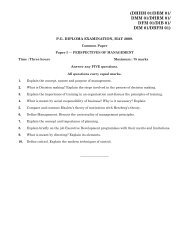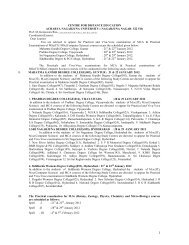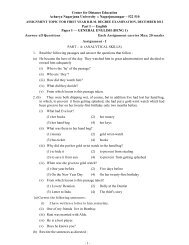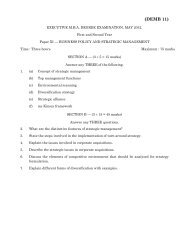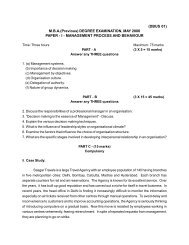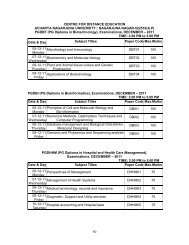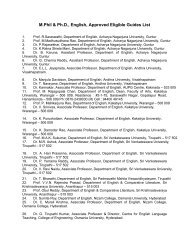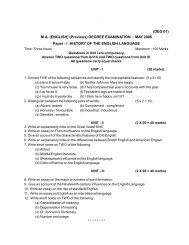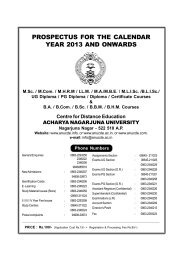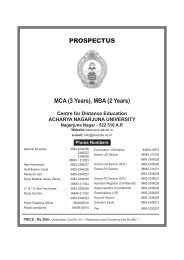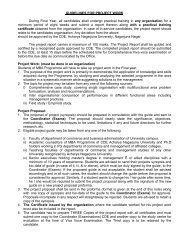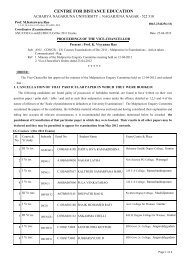II YEAR - ANUCDE
II YEAR - ANUCDE
II YEAR - ANUCDE
- No tags were found...
You also want an ePaper? Increase the reach of your titles
YUMPU automatically turns print PDFs into web optimized ePapers that Google loves.
(DBUS 21 (NR))Time : Three hoursM.B.A. DEGREE EXAMINATION, JUNE 2010.Second YearPaper I — FINANCIAL MANAGEMENTSECTION A — (3 × 5 = 15 marks)Answer any THREE of the following :Maximum : 75 marks1. (a) Retained earnings.(b)(c)(d)(e)(f)Operating leverage.Zero based budget.Funds from operation.Net income approach.Inventory management.SECTION B — (3 × 15 = 45 marks)Answer any THREE questions.2. Define the scope of financial management. What role should the financial manager play in amodern enterprise?3. Explain the advantages and disadvantages of preference shares to the company.4. Compute cash provided from operations during the year 2008, from the following data :Particulars April 1,2007March 31,2008Sundry debtors 30,000 40,000Sundry creditors 48,000 30,000Outstanding expenses 3,000 6,000Outstanding income 1,000 1,000Stock in trade 55,000 60,000Prepaid expenses 3,000 2,000Provision for doubtful accounts 1,500 2,000Accumulated depreciation(no retirements during the year) 50,000 60,000Dividends payable – 3,000Bills receivable 10,000 12,000Bills payable 8,000 6,000Net income (as per profit and loss account) – 80,000
5. Mittal Ltd., purchased a retail store and commenced business on April 1. From the followinginformation. You are required to prepare in as much details as possible, a trading and profitand loss account for the current year ended March 31 and a balance sheet as a the date.Rs.Capital introduced on April 1 47,000Drawings during the year 5,000Working capital (current assets lesscurrent liabilities) at March 31 23,000Depreciation of fixed assets during the yearbased on a rate of 20% per annum on cost 3,000Ratio of annual sales to year-end values offixed assets plus working capital 2 : 1Ratio of current assets to current liabilitiesat the year end 2 : 1Ratio of liquid assets (cash plus debtors)to current liabilities on March 31 5 : 4Debtors at the year end as percent ofannual sales 12General expense (excluding depreciation)as percent of annual sales 20The current assets consist of stocks (which are unchanged throughout the year), debtors andcash. Stock are turned over four times during the year. The current liabilities consists only ofcreditors.6. The sales and profit of a company during two periods were as follows :Period Sales ProfitI 1,00,000 10,000<strong>II</strong> 1,50,000 20,000(a)Find out the break-even point.(b) What amount of sales will generate a profit of Rs. 40,000?(c) What will be the profit if the sales are Rs. 1,20,000?7. Assuming the existence of the corporate income taxes, describe M-M’s position on the issue ofan optimum capital structure.2(DBUS 21 (NR))
SECTION C — (15 marks)(Compulsory)8. A company has on its books the following amounts and specific costs of each type of capital.Type of capitalBookvalueMarketvalueSpecificcosts %Rs.Rs.Debt 4,00,000 3,80,000 5Preference 1,00,000 1,10,000 8Equity 6,00,000 15Retained earnings 2,00,000 12,00,000 1313,00,000 16,90,000Determine the weighted average cost of capital using (a) book value weights and (b) marketvalue weights. How are they different? Can you think of a situation where the weightedaverage cost of capital would be same using either of the weights?———————3(DBUS 21 (NR))
(DBUS 21 (OR))M.B.A. DEGREE EXAMINATION, JUNE 2010.Second YearPaper I — FINANCIAL MANAGEMENTTime : Three hoursMaximum : 75 marksPART A — (3 × 5 = 15 marks)Answer any THREE of the following questions.1. (a) Wealth Maximization(b)(c)(d)(e)(f)Commercial PaperAverage Collection PeriodFinancial LeverageZero base BudgetingFactoring.PART B — (3 × 15 = 45 marks)Answer any THREE of the following.2. What are the major financial decisions? What rolea financial manager plays in a corporateenterprise?
3. Discuss the various ratios which are helpful toassess the financial health of an organization.4. What is meant by capital structure? Explain themajor determinants of capital structure planning.5. What is cost of capital? Critically examine thedifferent approaches for computing cost of equity.6. The Nagarjuna & Co. Ltd. is examining thequestion of relaxing its credit policy. It sells atpresent 20,000 units at a price of Rs. 100 per unit,the variable cost per unit is Rs. 86 and the averagecost per unit at the current sales volume is Rs. 90.All the sales are on credit, the average collectionperiod being 36 days. A relaxed credited policy isexpected to increase sales by 10% and the averageof receivables to 60 days. Assuming 14% returnshould the firm relax its credit policy?7. A firm uses 1000 units of a product per year. Itscarrying cost per unit is Rs. 2/- and ordering costis Rs. 50/-. It takes 15 days to receive a shipmentafter an order is initiated and the firm intends tohold inventory for 20 days’ usage as a safety stock.Calculate the EOQ and reorder point.PART C — (15 marks)(Compulsory)8. GVK Company is considering the followinginvestment proposals.ProjectsCash flows (Rs.)2 (DBUS 21 (OR))
A –10,000 +10,000B –10,000 +7,500 +7,500C –10,000 +2,000 +4,000 +12,000D –10,000 +10,000 +3,000 +3,000(a)(b)Rank the project according to each of thefollowing :(i)(ii)PaybackARR(iii) IRR and(iv) NPV assuming discount rate of 10%Assuming the projects are independent,which are should be accepted. If the projectsare mutually exclusive, which project is thebest?———————3(DBUS 21 (OR))
(DBUS 22)M.B.A. DEGREE EXAMINATION, JUNE 2010.Second YearPaper <strong>II</strong> — OPERATIONS MANAGEMENTTime : Three hoursMaximum : 75 marksSECTION A — (3 × 5 = 15 marks)Answer any THREE questions.1. (a) Facilities lay out.(b)(c)(d)(e)(f)ABC analysis.Bin card.Six sigma.Value analysis.Batch production.SECTION B — (3 × 15 = 45 marks)Answer any THREE questions.2. Define operation process and explain its keycomponents.3. What are the responsibilities of process planningengineer? Discuss the steps in process planning.
4. An electronic equipment contains 500 resistors.When any resistors fails, it is replaced. The cost ofreplacing a resistor individually is Rs. 20. If all theresistors are replaced at the same time. The costper resistor is Rs. 5. The percent surviving S(i) atthe end of month i is given in the following table.Percent Survival RateMonth I 0 1 2 3 4 5S (i) 100 90 75 55 30 0What is the optimum replacement plan?5. Explain different phases of production planningand control.6. What is quality assurance? How would you classifyquality control techniques?7. What are the types of model of inventory system?Explain them in detail.SECTION C — (15 marks)(Compulsory)8. A firm producing a single product has three plantsand four customers. The three plants will produce3,000, 5,000 and 4,000 units, respectively duringthe next week. The firm has made a commitmentto sell 4,000 units to customer A, 3,000 units to2(DBUS 22)
customer B and at least 1,000 units to customer C.Both customers 3 and 4 want to buy as many ofthe remaning units as possible. The net profitassociated with shipping a unit from plant i forsale customer J is given below :PlantCustomerA B C D1 65 63 62 642 68 67 65 623 63 60 59 60Management wishes to know how many units tosell to customer 3 and 4 and how many units toship from each of the plants to each of thecustomers to maximize profit.———————3(DBUS 22)
(DBUS 23) NRTime : Three hoursM.B.A. DEGREE EXAMINATION, JUNE 2010.Second YearPaper <strong>II</strong>I — MARKETING MANAGEMENTSECTION A — (3 × 5 = 15 marks)Answer any THREE questions.Maximum : 75 marks1. (a) Marketing mix.(b)(c)(d)(e)(f)Marketing of services.Product life cycleBrand.Publicity.Sales forecast.SECTION B — (3 × 15 = 45 marks)Answer any THREE questions.2. Discuss various “Marketing Concepts” and which is the best concept and why?3. What is Marketing Organisation? How do you plan a successful Marketing organisation?4. Define “Consumer Behaviour”. Explain the significance in modern marketing.5. What are new product ideas? Discuss the techniques of generating new product ideas.6. Discuss various pricing policies and strategies.7. Who are intermediaries? Explain different types of intermediaries.8. Case Study :SECTION C — (15 marks)(Compulsory)Sipani, an enthusiastic automobile engineer, had developed strong interest in the passengercar industry in the 1970s. He had a family background of timber trading and had no previousexperience in the car making industry. As an enthusiastic entrepreneur, he had first set upan automobile project and later he established Sunrise Auto Industries with an initial capitalof Rs. 106 lakhs in Bangalore in 1975. He developed a three – wheel prototype model with alambretta engine. He submitted the new prototype model to the Vehicle ResearchDevelopment Establishment (VRDIi) at Ahmednagar in Gujarat. Sipani’s three wheeledprototype was essentially a local made with fully indigenous components and it passed theVRDE test successfully.
Sipani decided to go in for a fiber glass body to his three-wheeler and he approached anautomobile consultant who had specialized in fiber glass technology. His consultant whoassociated with him in the Sunrise Automobile project justified the choice of a fiber glassbody because low investment when compared with the investment required for steel body interms of tooling cost. Die consultant further advised him that “fiber glass is not only moreeconomical but also lends itself to volume and design adaptability. In the case of deformityoccurs in steel, it is permanent but fiber glass is elastic and regain its shape” Hence, Sipaniwent for a fiber glass body for his new three-wheeled auto and branded it as ‘Badal’.Sipani launched ‘Badal’ with a price Rs. 12000 at ex-factor cost in 1977. The sunrise Autoindustry h.id secured licenses to run the Badal as a taxi in several States includingMaharastra and had enough bookings. But, Sunrise’s production of ‘Badal’ depended totallyon the power pack supplied by scooters’ India Ltd., a public sector enterprise, at the time. Asthe power pack supplier failed to fulfill his obligation, it terribly affected the productionschedule of Badal and Sunrise came across severe criticism from various quarters. Itdamaged the company’s credibility and its commitment to customers was suspected. Sipani,the proprietor of Sunrise, was branded as ‘fly-by-might trader. But, Sipani never gotdiscouraged and gave up easily. His mantra was ‘Never say Die’ in the auto business andwent on.Now, he ventured into four wheeler. He renamed his Sunrise Auto as Sipani AutomobileLtd., in 1979. This time, for his proposed four-wheeler, the UK based Reliant companyexpressed instant interest when he approached it. Reliant company was one of the largestfiber glass body makers in the world. A team of Reliant officials came to India and visited allthe automobile manufactures for searching contract for fiber glass technology. No oneshowed any interest except Sipani Automobiles and Reliant considered Sipani as the bestcandidate for its fiber glass technology In 1981, Sipani executed a contract with ReliantCompany for the fiber glass body technology and subsequently he had got governmentclearance. Then he went on to mobilizing his resources to manufacture the four-wheelerpassengercar, particularly he raised finance from the Karnataka State Industrial FinanceCorporation.Experts in the auto industry opined that the Reliant technology was 30 years old anddumped this old technology to Sipani Automobiles. Sipani, did not deny the experts opinionand convinced himself that he did not make any mistake. His very strong belief was that inan uncertain Indian Market, it was not really viable to make a Rs. 200 crores investment inorder to acquire the latest technology. His total investment was about Rs. 3 crores in his petSipani Automobile car project. So, he was able to produce a decent car with fiber glass bodyand he branched it as ‘Dolphin’. The vehicle was light weight and fuel efficient. Many usersfelt that the vehicle could be driven continuously for 5 to 6 hours (400-500 kms) withoutbreaking in the journey. The vehicle had an indigenous components of 70 per cent and hadsingle door with fiber glass body. Sipani priced the vehicle at Rs 57,500/which was aboutRs. 9000/-higher that of the price of Maruti 800 cc. He convinced that maruti’s price was notrealistic and he predicted that the Maruti’s 800 cc vehicle’s price would steadily rise. Ofcourse, his prediction was right. Maruti’s price went up to 1.6 lakhs by the close of 1980s andfurther went up to 2.25 lakhs by the middle of 1990s.By the middle of 1980s, the demand for ‘Dolphin declined and Sipani was not able tomaintain his production schedule. Meanwhile, in the middle of 80s he brought a double doorcar which was known by the brand name “Montona”. The double door ‘‘Montona” too faced lotof problems. Sipani could not maintain his production schedule as well as service back upthough there were enough bookings for his vehicles. As a result, Sipani Automobile facedsevere financial crisis and the Karnataka government issued legal notices to Sipani by thebeginning of 1990 and went to the extent of attaching the properties of Sipani Automobiles.Eventually SAL disappeared from the Indian auto industry.2(DBUS 23) NR
Questions for Discussion(a) Evaluate Sipani’s entrepreneurial/marketing skills.(b) What were the reasons for SAL’s failure?(c) Discuss the case of SAL in the context of the current passenger car market India.———————3(DBUS 23) NR
(DBUS 23 (OR))M.B.A. DEGREE EXAMINATION, JUNE 2010.Second YearPaper <strong>II</strong>I — MARKETING MANAGEMENTTime : Three hoursMaximum : 75 marksSECTION A — (3 × 5 = 15 marks)Answer any THREE of the following.1. (a) Marketing segmentation.(b)(c)(d)(e)(f)Marketing Research.Product life cycle.Sales promotion.Sales forecasting.Push strategy.SECTION B — (3 × 15 = 45 marks)Answer any THREE of the following.2. What are the basic challenges faced by marketing organizations?3. What are the factors influencing the consumer behavior.4. What do you understand about trading up and trading down?5. Explain the objectives of pricing policy of business firms.6. “Advertising and personal selling are complementary to each other”. Comment.7. Discuss the importance of branding and packing in the Indian selling.
SECTION C — (15 marks)8. Case Study :Krishna Candy Company is a medium sized chocolate manufacturer located in Vijayawada.In the last two years Its sales and profits have barely held their own. Top management of thecompany feels that the trouble lies with the sales force: some how they do not ‘work hard orare not smart enough’. To correct this, management is planning to introduce a new incentivecompensation system and is planning to hire high powered specialist to train the salesmen inmodern merchandising and selling techniques.The company recently conducted research about its customer profile. Its products appealespecially to lower income and older people. Respondents who were asked to assess Krishnachocolate products in relation to competitor’s products described them as ‘average qualityand a bit of old fashioned’.Krishna Canady Company sells its products to candy jobbers and large chains. Its salesmencall on many of the small retailers reached by the candy jobbers to fortify displays andprovide ideas; its salesmen also call on many small retailers not covered by jobbers. KrishnaCandy Company enjoys good penetration of small retailing, although not in all segmentssuch as the fast growing restaurant areas. Its major approach to middlemen is a ‘sell in;strategy; discounts, exclusively contracts and stock financing. At the same time KrishnaCandy Company does not do too well in penetrating the various chains. Some of itscompetitors rely much more heavily on mass consumer advertising and store merchandisingand are not successful with the large chains.Krishna Canady Company’s marketing budget amounts to about 15% of its total sales,compared with competitors budget of close to 20%. Most of the marketing budget supportsthe sales force and the remainder supports advertising; consumer promotions are verylimited. The advertising budget is spent primarily in reminder advertising for ‘the company’stwo leading products. New products are not developed often, and when they are, they areintroduced to retailers by using a ‘push’ strategy.The marketing organization is headed by a Marketing Manager reporting to him is the SalesForce Manager, the Marketing Research Manager and the Advertising Manager. Havingcome up from the ranks, the Marketing Manager is partial to sales force activities and paysless attention to the other Marketing functions.2(DBUS 23 (OR))
The company has called you in as a Marketing Auditor to review its imminent plans to ‘givesales force a short in the arm’ by introducing a new incentive compensation plan and salestraining programme.Questions:(a)(b)Do you think this will turn the tide?If not, what do you think the company ought to do?———————3(DBUS 23 (OR))
(DBUS 24 (NR))M.B.A. DEGREE EXAMINATION, JUNE 2010.Second YearPaper IV — HUMAN RESOURCE MANAGEMENTTime : Three hoursMaximum : 75 marksSECTION A — (3 × 5 = 15 marks)Answer any THREE questions.1. (a) Human Resource Development.(b)(c)(d)(e)(f)Job Description.Fringe benefits.Employee discipline.Industrial democracy.Arbitration.SECTION B — (3 × 15 = 45 marks)Answer any THREE questions.2. Describe the nature and scope for personalfunction in an organisation? What are theindicators of its working in an organisation?
3. Briefly explain the concept of selection. What arethe different techniques of selection following by apersonnel manager, while employing the personnelin an organisation?4. Explain the post appraisal interview problembetween the superior and the subordinate.5. Briefly outline the purpose of a pay commission.How is it constituted?6. What are the functions of industrial relations?State the different approaches to Industrialrelations.7. Why do trade unions in India often fail to achievetheir objectives? Suggest measures for thesuccessful functioning of trade unions.8. Job Specification.SECTION C — (15 marks)(Compulsory)Mr. Kishore is a Branch Manager of Indian Bankat one of its Village Branch. His staff included twoclerks and an attender. Very often Mr. Kishorewas left alone in the bank after 5 p.m. to tallyaccounts, day books and complete all otherformalities.2(DBUS 24 (NR))
On the 30 th December Mr. Kishore was workingtill past 2 a.m. tallying the accounts since hardlyone day is left for closing the accounts for the year.On this fateful night, the Branch Manager wasattacked by a band of robbers. Who lootedRs. 5 lakhs after brutally wounding Mr. Kishoreright hand, which had to be amplitated later?After his recovery the Branch Manage applied forcompensation. The Bank Management was of theopinion that Mr. Kishore violated the JobSpecification by working beyond the stipulatedhours of work. He, in their views, was not entitledto any compensation as the accident occurredduring non-employment hours. They also called foran explanation as to why the amount lost cannotbe recovered from his salary and provident fund.Questions :(a)(b)How do you justify the bank's stand in thiscase?What modifications do you suggest in jobspecification to overcome such incidents infuture?———————3(DBUS 24 (NR))
(DBUS 24 (OR))M.B.A. DEGREE EXAMINATION, JUNE 2010.Second YearPaper IV — HUMAN RESOURCE MANAGEMENTTime : Three hoursMaximum : 75 marksSECTION A — (3 × 5 = 15 marks)Answer any THREE of the following.1. (a) Functions of HRM.(b)(c)(d)(e)(f)Manpower planning.Induction.Job enlargement.Industrial conflict.Grievance Handling.SECTION B — (3 × 15 = 45 marks)Answer any THREE of the following.2. Explain the importance of Human ResourceManagement in the changing businessenvironment of today.3. Differentiate between training and development.Discuss the various types of training.
4. Discuss the objectives of performance appraisal.Why do we carry performance appraisal in anorganization?5. Discuss the various factors influencing thecompensation polices in an organization.6. Explain the process for exercising the power totake disciplinary action against erring workman inan organization.7. What are industrial relations? Examine the role oftrade unions in managing industrial relations inIndia.8. Case Study :SECTION C — (15 marks)(Compulsory)Mohan, a senior operator in a company has beenworking in engineering firm manufacturing shafts.He joins a workers’ union in 2001. The union has astrong hold over the workers. Mohan was therepresentative of his department. Most of his timewas involved with union activities. In 2002, he wasseriously injured in a clash with his co-workers forsome particular reason. He was suspended by themanagement for six months. During this period,the management, after a thorough enquiry, foundout the real cause of the clash.2(DBUS 24 (OR))
Under pressure from the union, Mohan wasreinstated in the factory in 2001. Mohan meanwhile continued in his own union. Mohan resumedhis duties but did not perform as well as he usedto before the clash with his co-workers. Whenasked by his immediate supervisor Mr. Ramesh,to explain as to why his performance haddeteriorated he said that he could not lift heavymaterials because; of his injury. The supervisortried to motivate him to improve his performancebut to no effect.As the appointment of Mohan was made on therecommendation of Mr. Mehra, a senior officer ofthe production department, Mr. Ramesh apprisedhim of Mohan’s performance. A decision was takenby both the officials that Mohan be transferred tothe production department. This again had noeffect on Mohan’s performance and his attitude towork remained unchanged. He was thereaftertransferred back to his former departmentQuestions :(a)(b)(c)Should Mohan have been transferred back tohis former department?Comment upon Mr. Ramesh and Mr. Mehra’sjoint decision.What do you think could have been thetreasons for Mohan’s behavior?——————3(DBUS 24 (OR))
(DBUS 25)M.B.A. DEGREE EXAMINATION, JUNE 2010.Second YearPaper V — RESEARCH METHODOLOGY FORMANAGEMENT DECISIONSTime : Three hoursSECTION A — (3 × 5 = 15 marks)Maximum : 75 marksAnswer any THREE of the following.1. (a) Design of questionnaire.(b)(c)(d)(e)(f)Secondary data.ANOVA.Chi-square distribution.Null hypothesis.One-sample sign test.SECTION B — (3 × 15 = 45 marks)Answer any THREE of the following.2. Define research and examine its characteristics.3. Describe the merits and demerits of proportionatestratified sampling.
4. What are the uses of secondary data and what aretheir advantages and limitations?5. Describe the functions of data collection tools.6. What are the characteristics of research report?What functions does this report perform?7. Discuss the importance of Chi-square test inresearch.SECTION C — (15 marks)(Compulsory)8. The number of vehicles produced per week inseven plants of Alpha Auto company before andafter introducing modern computer package forline balancing in summarized below :Week Before After1 600 6252 550 6003 620 5754 700 7205 575 6006 630 6507 575 5002(DBUS 25)
Check whether the number of vehicles producedper week before and after introducing thecomputer package are different in the plants usingsign test at a significance level of 0.05.——————3(DBUS 25)
(DBUS 26)M.B.A. DEGREE EXAMINATION, JUNE 2010.Second YearPaper VI — BUSINESS POLICY AND STRATEGICMANAGEMENTTime : Three hoursPART A — (3 × 5 = 15 marks)Answer any THREE questions.1. (a) 7s frame work.Maximum : 75 marks(b)(c)(d)(e)(f)Functions of managing director.Transnational strategy.Life cycle analysis.Balanced scorecard.Core-competency.PART B — (3 × 15 = 45 marks)Answer any THREE questions.2. What are the changes taking place in the Indianenvironment which support the study of corporatepolicy?
3. What are the basic functions and responsibilitiesof the senior management?4. How can a SWOT analysis help in shortlistingstrategic alternatives at the corporate level?5. What are the five competitive forces in an industryas identified by Michael porter?6. Enumerate the different structural mechanismsrequired to implement a strategy.7. Distinguish between strategic control andoperational control.PART C — (15 marks)(Compulsory)8. Changing tastes and preferences of customers,upward mobility, rising disposable income,availability of a variety of products and services,lifting of the quantitative restrictions on imports,and increasing exposure to internationalstandards have led to a retail revolution in India.The Mumbai based Akbarallys is conscious ofthese developments.2(DBUS 26)
A Pioner of the concept of shopping under one roof.Akbarally Ebrahimji set up a 300 sq ft drug storein 1897 that today has metamorphosed into asprawling retail chain. There are five departmentstores at different locations in Mumbai generatingsale of more than Rs. 50 crore. The 32 countersstock more than 20,000 products ranging fromelectronic goods to garments.The strong points of the ratail chain are the rangeof products offered and convenient locations thatare over-shadowed by its cramped and shoddyinteriors and poor service. But recent make over indecor and managerial actions at enhancingemployee skills and merchandising offer scope forimproving the profitability. Focus is on stockingproducts like garments that have a highermargins as compared to food and drugs thatdo not. Competition is imminent from local retailbrands and international chains contemplatingentry into India. A strategic option is to go in forfranchisee arrangements in major metropolitancities. The aim is to establish a mall as an anchorstore surrounded by well-known retailers. Anotherproject is to set up the Akbarally institute ofretailing affiliated to the University of Bombay.3(DBUS 26)
The business is managed wholly by the threeKhorakiwala brothers and their children.The second-generation family members areprofessionally trained in management. The seniorpositions are manned by professionals. Besidesretailing, the family is also into furniture centresin Mumbai. Its other business that is better knownis Wockhardt, a leading pharmaceutical company.The chanllenge before the family business is keepchanging itself to remain on the top.Questions :Analyse the retailing operation of Akbarally fromthe view point of strategic management. Do youfeel that the organisation is geared to face newchallenges? What needs to be done additionally tosecure continued success?———————4(DBUS 26)



